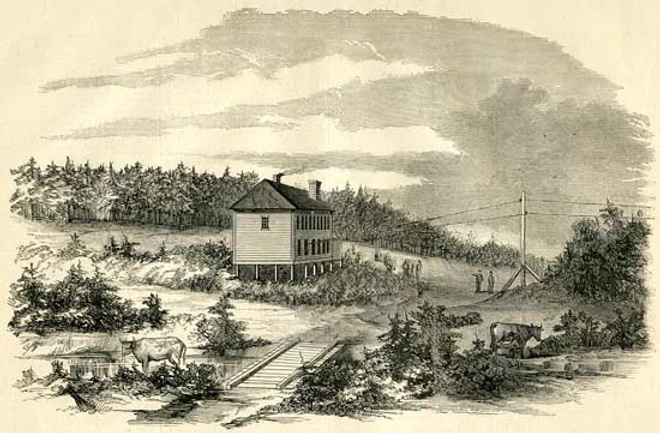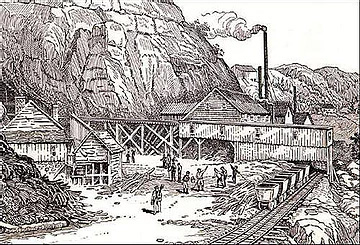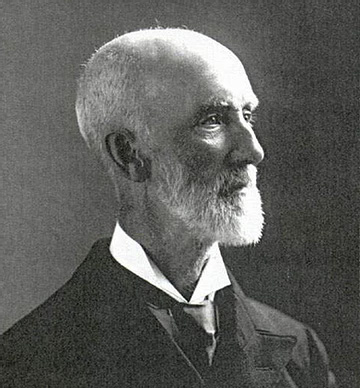 The year is 1878 in an area of Newfoundland still known as Indian Bight and the Little Bay mines are just about to start. And due to an act of fortune or foresight the site has a brand new telegraph office already in place, the line extended there earlier that year (Prowse, P. 566). The presence of a telegraph office would prove an interesting detail for the little mining town. They were still pretty rare in 1878 and caught some attention.
The year is 1878 in an area of Newfoundland still known as Indian Bight and the Little Bay mines are just about to start. And due to an act of fortune or foresight the site has a brand new telegraph office already in place, the line extended there earlier that year (Prowse, P. 566). The presence of a telegraph office would prove an interesting detail for the little mining town. They were still pretty rare in 1878 and caught some attention.
Geological surveyor James Howley wrote of his visit in July of 1878 “I arrived at Indian Bight while prospecting my survey of Little Bay, and camped on the unoccupied beach. The place had never been inhabited [and was as] wild and forlorn an appearance as any in the Bay of Notre Dame. The mine had just been discovered” (Journal of the House of Assembly, P. 571). “A fisherman from Wild Bite (now Beachside) [named] Robert Colbourne was hunting caribou [when he] noticed a piece of copper ore [and subsequently] Dr. Henry Eales of London and Adolph Guzman of the Bett’s Cove Mining Company [. . .] proceeded to [mine it]” (Moments in Time, P.80). But don’t worry, Mr. Colbourne got some tea and butter for his part in it all (Martin).
 The new site came at the right time as it “coincided with depletion of the highgrade and most easily accessible ore at Betts Cove, Guzman had little difficulty in persuading Ellershausen to lease the Little Bay claim for a royalty of 8 shillings per ton [and] men and machinery floated from Betts Cove across Green Bay to Little Bay” (Martin). The site “was secured by Mr. Francis Ellershausen, a gentleman of great energy [. . .] who [quickly put] a thousand miners to work” (The Book of Newfoundland, P. 411). And so, “The Betts Cove mine [under] Ellershausen began to transfer [. . .] men and machinery to the Little Bay deposit” (Martin).
The new site came at the right time as it “coincided with depletion of the highgrade and most easily accessible ore at Betts Cove, Guzman had little difficulty in persuading Ellershausen to lease the Little Bay claim for a royalty of 8 shillings per ton [and] men and machinery floated from Betts Cove across Green Bay to Little Bay” (Martin). The site “was secured by Mr. Francis Ellershausen, a gentleman of great energy [. . .] who [quickly put] a thousand miners to work” (The Book of Newfoundland, P. 411). And so, “The Betts Cove mine [under] Ellershausen began to transfer [. . .] men and machinery to the Little Bay deposit” (Martin).
Howley had noted the absence of a population during his July visit but returning in September he found a booming population of over 500 and was “astonished to observe the changes that had taken place” (Journal of the House of Assembly, P. 572). “Work began at the Little Bay mines on August 12th” and Rev. Archibald Gunn noted in November that the population had grown to 1500 (Moncrieff). The town’s surgeon, Dr. Stafford was hired this fall (Twillingate Sun). And the mailman’s name was Jimmy Batstone.
“While some men transformed the silent wilderness into a mine site with houses, a tramway and pier, others assembled the first shipment of ore” (Martin). Howley described the result as “a pretty little town, which already boasted three regularly laid out streets [with] a range of comfortable houses [and] a large well-built store with a fine wharf [and also a] shop, office, [and finer houses for the manager and officials], a well-constructed tramway [supplying] a large iron steamer [and] near the wharf [more] buildings, and the foundation of a large new smelting equipment” (Journal of the House of Assembly, P. 572).
 Rev. Gunn described the transition, writing “The howling wilderness was in a few weeks converted into a struggling village supporting a busy population. … There was a larger population but no clergyman to look after their spiritual wants” (Moncrieff). The churches sent representatives to oversee the lost flocks; Rev. Arthur Pittman for the Church of England and Rev. Stephen O’Flynn for the Roman Catholic Church (Prowse, P. 603, 615). These men would play major roles in shaping the community.
Rev. Gunn described the transition, writing “The howling wilderness was in a few weeks converted into a struggling village supporting a busy population. … There was a larger population but no clergyman to look after their spiritual wants” (Moncrieff). The churches sent representatives to oversee the lost flocks; Rev. Arthur Pittman for the Church of England and Rev. Stephen O’Flynn for the Roman Catholic Church (Prowse, P. 603, 615). These men would play major roles in shaping the community.
Families from across the island came seeking work and then they did what humans do best – made more humans. Like any year 1878 had its weddings and its births and some family names were recorded as a result, they include; Brown, Hanrahan, and Walsh. The Bouzane family also arrived in 1878 (Deck’s Awash, Vol. 17 No. 5).
 But the new labour class weren’t the only people drawn to the site. The new mine was hot news and so attracted its share of uppity-up looky-lous. “A party of ten, including Governor Glover and Rev. Moses Harvey [visited] aboard the steamer Hercules [. . .] on September 21, 1878 [to see the] local copper mines” (Boyles). This was just two weeks after the site’s opening and Reverend Harvey described the experience saying, “we started for the mine, Mr. Ellershausen leading the way with rapid strides…till panting and exhausted, we reach the summit, scramble through a little morass, and there is Little Bay mine. What a sight we gaze upon here! It is simply a great cliff of copper ore that we are looking at…On the face of this copper cliff the miners [. . .] at work quarrying literally the great blocks of copper. The bottom of the cliff is strewed with these glittering masses, small and great, and piles are being heaped up for shipment” (Harvey).
But the new labour class weren’t the only people drawn to the site. The new mine was hot news and so attracted its share of uppity-up looky-lous. “A party of ten, including Governor Glover and Rev. Moses Harvey [visited] aboard the steamer Hercules [. . .] on September 21, 1878 [to see the] local copper mines” (Boyles). This was just two weeks after the site’s opening and Reverend Harvey described the experience saying, “we started for the mine, Mr. Ellershausen leading the way with rapid strides…till panting and exhausted, we reach the summit, scramble through a little morass, and there is Little Bay mine. What a sight we gaze upon here! It is simply a great cliff of copper ore that we are looking at…On the face of this copper cliff the miners [. . .] at work quarrying literally the great blocks of copper. The bottom of the cliff is strewed with these glittering masses, small and great, and piles are being heaped up for shipment” (Harvey).
Of his visit in September, Howley described how “The mine itself partook more of the character of an open quarry [as] the ore had been taken out from near the surface, by blasting and quarrying down the sides of the bluff in huge masses (Journal of the House of Assembly, P. 572). But preparation was underway for the winter’s work underground and the “miners sank shafts in November and by December had shipped 10,000 tons of ore to Swansea – an amazing feat, considering that every pound of ore had to be blasted, raised and loaded by hand” (Martin). Howley exclaimed, “The name of this locality was unknown [until] the discovery of the mine seven months ago [and now it is] nearly as well known and celebrated as Betts Cove or Tilt Cove” (Journal of the House of Assembly, P. 537). By year’s end Little Bay operations overshadowed the previous efforts at Tilt Cove and Betts Cove (Moncrieff). In short time the Little Bay mine had “thrown the others completely into the shade, and may be regarded as one of the most valuable copper mines in the world” (The Book of Newfoundland).
Mining was all the rage in contrast to much of the island. The reported numbers of fishing boats and their hauls for the area’s communities was released on August 3rd and Indian Bight could claim only one lonely trawler (Harbour Grace Standard). Meanwhile, behind the scenes schemers were scheming with plans already in motion to change the mine’s claims and ownership. Ellershausen had worked with Premier William Whiteway to put Dr. Eales’ name on the original claim by replacing someone else’s (Martin). That was just the start of some seriously shady backdoor goings-on. The Premier’s involvement wouldn’t come to light until 1881 through some fine journalism by the Evening Telegram, but that’s getting a little ahead of ourselves. The Little Bay scandals, by’s, you got no idea.
That’s year one. The year was 1878 and the ride just got started – you ain’t heard the half of it yet!
Sources:
“Moments in Time: A Cultural Portrait of Green Bay, Newfoundland” 1994
“Deck’s Awash, Vol. 17 No. 5” 1985
Martin, Wendy “Once Upon a Mine: Story of the Pre-Confederation Mines on the Island of Newfoundland” 1983
Boyles, Frank R “Grace United Church, Springdale 1880-1980” 1980
“The Book of Newfoundland” 1967
Moncrieff, Wilfred M “A History of the Presbyterian Church in Newfoundland 1842-1967” 1966
Prowse, “A History of Newfoundland” 1895
“Twillingate Sun” 1882
“Journal of the House of Assembly” 1879
Harvey, Moses “Across Newfoundland, with the Governor; A Visit to our Mining Regions; and This Newfoundland of Ours: Being a Series of papers on the Natural Resources and Future Prospects of the Colony” 1879
“Harbour Grace Standard” 1878
Residents:
* Baron Franz von Ellershausen – mine management (Martin)
* Adolf Guzman – mine management (Martin)
* Reverend Arthur Pittman – Church of England (Moncrieff)
* Reverend Stephen O’Flynn – Catholic Church (Moncrieff)
* Dr. Stafford – town surgeon (Twillingate Sun, Sept 1882)
* Jimmy Batstone – mailman (Howley)
* The Head family – miners (Atlantic Guardian, Sept 1948)
* The Bouzane family – tree cutters (Deck’s Awash, Vol. 17 No.5)
* Isabel Starks – maiden name unknown (birth from 1921 census)
* Edward Brown (birth from 1921 census)
* John Walsh (birth from 1921 census)
* James Walsh (birth from 1945 census)
* John J Hanrahan (birth from 1945 census)
* A 1901 marriage in Glace Bay, NS notes the birth of Kenneth G. Tilley in Little Bay Twins to Robert and Susannah.
